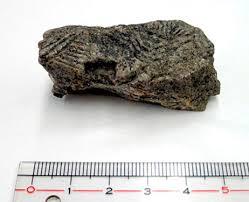Shunsuke Nakamura
Source - http://ajw.asahi.com/article/behind_news/social_affairs/AJ201505280061
 The fragment of a mold for casting the Tachukyo (mirror with knobs) discovered in Kasuga, Fukuoka Prefecture (Shunsuke Nakamura)
The fragment of a mold for casting the Tachukyo (mirror with knobs) discovered in Kasuga, Fukuoka Prefecture (Shunsuke Nakamura)
A fragment of an ancient mold used to produce bronze mirrors that was found here predates any other artifacts linked to mirror production in Japan by up to 200 years.
The mold fragment dates to around 200 B.C. and was found during an archaeological dig at the Sugu Takauta ruins in Kasuga, the city's board of education announced May 27.
The mold was apparently used to produce bronze mirrors known as Tachukyo (mirror with knobs) during the first half of the middle Yayoi Pottery Culture (300 B.C.-A.D. 300).
The discovery topples the widely accepted view that these kinds of mirrors were imported from the Korean Peninsula and suggests that production of mirrors took place earlier in Japan when metal-tool culture arrived.
It was believed that the first mirrors produced in Japan were the Kogata Boseikyo (small "imitation" mirror), which were imitations of Chinese mirrors, but the mold fragment predates this by 150 to 200 years.
The mold fragment is made from talc and measures 5.1 centimeters in length, 2.5 cm in width and 2.3 cm in thickness. It weighs 39 grams and has indentations to create knobs on the mirror's rear as well as straight lines and curves. If intact, the whole mold would have been circular with a diameter of about 15 centimeters.
 Which part of a bronze mirror the unearthed mold fragment would have cast is indicated by the gray silhouette (Provided by Kasuga board of education)
Which part of a bronze mirror the unearthed mold fragment would have cast is indicated by the gray silhouette (Provided by Kasuga board of education)
Tachukyo mirrors, characterized by two or more knobs on the back, were commonly produced in the Korean Peninsula and northeast China.
Twelve examples of a mirror known as the Tachu Saimonkyo (mirror with knobs and detailed patterns) dating to between the fourth and second centuries B.C. have been found in the Kyushu and Kinki regions as well as Yamaguchi Prefecture. They were mainly discovered in the tombs of powerful figures of the era.
But the patterns on the mold fragment are rougher than those of the Tachu Saimonkyo and resemble markings on another variant, the Tachu Somonkyo (mirror with knobs and rough patterns).
However, the mold is from a later era than the Tachu Somonkyo, which was made between the eighth and fourth centuries B.C. In addition, some of its patterns are different from the designs found on bronze mirrors discovered so far.
The board of education concluded that the mold was an attempt to produce the Tachu Saimonkyo in Japan. They used other bronze molds and pottery unearthed from the same ruins to reach this conclusion.
"This has added a new chapter in uncovering the situation of early bronze tool production in Japan," said Junichi Takesue, a professor of archaeology at Fukuoka University.
The Sugu Takauta ruins are located in the central area of Nakoku, a kingdom within Japan that had been given a gold seal from the Chinese emperor, as mentioned in the "Gishiwajinden" (Biography of the Wa people) chronicle of "Wei Zhi," which is the official history book of the Wei Dynasty. Nakoku is known to have flourished through the production of bronze.